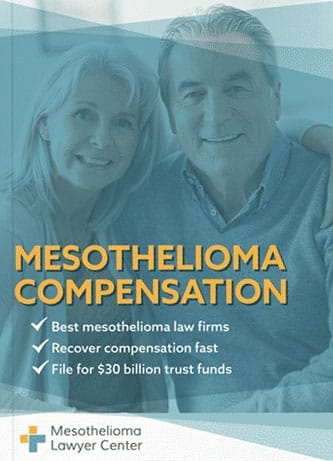General Motors (GM) is a major automotive company that made, used, and sold asbestos auto parts between the 1920s and 1990s. GM asbestos parts caused exposure and illnesses in many people, some of whom filed lawsuits against the company. GM filed for bankruptcy in 2009 and created an asbestos trust fund to compensate claimants.
If you’ve been diagnosed with mesothelioma, asbestosis, or asbestos-related lung cancer, remember that you may be eligible for substantial compensation. There is currently over $30 billion in asbestos trust funds set up for victims of asbestos-related diseases. Fill out our form to receive our free Financial Compensation Packet. Our packet is loaded with information on experienced mesothelioma attorneys in your area, how to file a claim for asbestos trust funds, how to get paid in 90 days, and more.


FREE Financial Compensation Packet
- Info on law firms that will recover your HIGHEST COMPENSATION
- Learn how to get paid in 90 days
- File for your share of $30 billion in trust funds

Did GM Use Asbestos?
Asbestos was once a common material used in friction automotive parts, like brakes, clutches, and even body parts. GM used asbestos in many parts from the 1920s to the 1990s. Asbestos reduced the risk of overheating from friction and the potential dangers of fire.
GM History
The history of GM began when William C. Durant, owner of Buick Motors, formed the General Motors Corporation in 1908.
- Durant bought more than 20 companies and established all of them under the name of GM. At the time, Ford Motor Company was one of the leading vehicle businesses. Durant set up GM to compete directly with it.
- A little after 1918, Durant lost control of GM when the market for vehicles crashed. Alfred P. Slogan, a business executive, replaced Durant and acquired seven Chevrolet-managed manufacturing plants.
- GM’s business picked up substantially over the next several decades. In addition to vehicles, the company began manufacturing and selling vehicle parts.
- During World War II, GM contributed to the war effort, helping to build ships, weapons, tanks, and airplanes. GM thrived in the years after the war and, for many years, was the world’s largest car maker.
- During the 1960s, GM varied its business by adding subsidiaries that included insurance, electronics, trains, banking, and financing.
- During the 1970s, competition with other vehicle manufacturers, such as Japan’s smaller, more efficient vehicles, caused difficulties for GM. Other issues at the time included the rising costs of pensions and healthcare.
- The bulkier GM cars became known as “gas guzzlers” and contributors to air pollution. The company lost around 35% in sales and was fined nearly $5 billion for pollution regulations.
- GM spent most of the 1980s trying to redesign its models, but by the early 1990s, it had already lost close to $60 billion.
- The company’s losses grew when former employees and contractors filed asbestos-related claims. The lawsuits and claims stemmed from GM’s use of asbestos in automotive parts.
- GM also faced liability for asbestos in non-automotive products made by some of its acquisitions. These included asbestos-insulated boilers made by Delco Appliance.
GM filed for bankruptcy in 2009. The company reorganized and benefitted from a bailout provided by the federal government. As part of the reorganization plan, GM set up an asbestos trust fund.
GM Products That Contained Asbestos
Until the 1990s, GM not only bought asbestos-containing parts from other companies but also used asbestos in many of its own products, including:
- Disc and drum brakes
- Automatic transmissions
- Adhesives
- Engines
- Gaskets
- Manual transmissions
- Frigidaire appliances
- Delco-Heat appliances and boilers
- Clutch linings
- Brake linings
- Locomotive brake shoes
BorgWarner was one of the leading companies that supplied GM with asbestos products.
Who Was Affected by GM Asbestos Products?
The wide use of asbestos by GM and the entire automotive industry put many people at risk for asbestos exposure and resulting illnesses like malignant mesothelioma and lung cancer.
Some of the occupations placed at high risk for developing an asbestos-related disease include:
- Vehicle mechanics
- Auto parts installers
- Factory workers
- Warehouse workers
- Brake assemblers
- Clutch assemblers
- Engineers
- Machinists
Mechanics had a particularly high risk of exposure to asbestos when working on GM vehicles. They removed, handled, and manipulated asbestos products, which often caused the release of harmful fibers. Mechanics at the highest risk of asbestos exposure worked on clutches and brakes.
Mechanics continue to be at risk today if they work with older vehicles or aftermarket parts, which often still contain asbestos. Home mechanics who worked on their own GM vehicles also risked exposure and now may be diagnosed with asbestos illnesses.
GM Plants With Ongoing Asbestos Contamination
Automotive companies often shut down factories and plants, leaving toxic substances in place that can harm communities. In Newport, Delaware, a former GM plant has raised concerns over asbestos exposure.
There are plans to convert the shuttered factor into a business park, but doing so requires significant asbestos abatement. An abatement company working on the project violated safety regulations, putting workers and nearby residents at risk of exposure.
Whistleblowers filmed work at the site that showed uncontrolled asbestos fibers swirling in the air. The company was fined for the safety issues.
Another closed GM plant is causing issues in St. Catharines, Ontario. The factory once made asbestos brakes, and asbestos lingers in the structure. Residents have complained about the dangers since the facility was abandoned in 2018.
GM Lawsuits and Bankruptcy
GM faced numerous asbestos-related claims, yet most of the cases stemmed from employees and contractors who worked with and around the company’s clutch facings and brake linings. As the claims continued to surface, GM faced over $636 million in asbestos-related cases by 2009.
One example of a GM asbestos lawsuit came from auto mechanic Roland Grenier. He worked on GM and other vehicles for over 40 years, often grinding and repairing brake and clutch components. He developed mesothelioma in 2005 and sued GM and others. Grenier won a $2 million verdict. The jury held GM 70% liable.
The company filed for Chapter 11 bankruptcy shortly after, which included a reorganization plan and the establishment of an asbestos trust fund to compensate future and pending claimants.
When GM emerged from bankruptcy, debt from all asbestos-related claims was transferred to the Motors Liquidation Company.
In 2012, The Motors Liquidation Company Asbestos PI Trust was created. Around $625 million was placed into the fund to compensate asbestos claimants.
Does GM Still Use Asbestos?
GM is still in business today but no longer uses asbestos in automotive parts. Still, older GM vehicles and aftermarket parts may contain asbestos.
The company has paid back $49.5 billion that it received from the government in 2009 and no longer uses asbestos in any of its products.
If You Were Exposed to GM Asbestos Products
If you suffered harm from GM products with asbestos, contact an experienced asbestos law firm to help you seek compensation.
A mesothelioma lawyer can help you make a successful claim with the asbestos trust. They can also review your work history and find other companies that exposed you to asbestos.
You could be eligible for claims with multiple trusts. You may also be in a position to sue companies that exposed you and hold them liable for damages.
Additional Resources and Information for Asbestos Victims
If you’ve been injured by asbestos, there is a good chance that you’ll qualify for considerable compensation. Remember to fill out our form to get your free Financial Compensation Packet, with information on asbestos and mesothelioma lawyers in your area. If you have questions or need additional assistance, contact us at 800-793-4540.

Paul Danziger
Reviewer and EditorPaul Danziger grew up in Houston, Texas and earned a law degree from Northwestern University School of Law in Chicago. For over 25 years years he has focused on representing mesothelioma cancer victims and others hurt by asbestos exposure. Paul and his law firm have represented thousands of people diagnosed with mesothelioma, asbestosis, and lung cancer, recovering significant compensation for injured clients. Every client is extremely important to Paul and he will take every call from clients who want to speak with him. Paul and his law firm handle mesothelioma cases throughout the United States.
References
- Detroit Historical Society. (n.d.). Encyclopedia of Detroit.
Retrieved from: https://detroithistorical.org/learn/encyclopedia-of-detroit/general-motors - U.S. Bankruptcy Court, Southern District New York. (2011, March 7). In re. Motors Liquidation Company.
Retrieved from: https://casetext.com/case/in-re-motors-liquidation-company-11 - MFR CLaims. (n.d.). About MFR Claims Inc.
Retrieved from: https://www.mfrclaims.com/#about - Whoriskey, P. (2009, July 10). GM Emerges From Bankruptcy After Landmark Government Bailout. Washington Post.
Retrieved from: http://www.washingtonpost.com/wp-dyn/content/article/2009/07/10/AR2009071001473.html?sid=ST2009071002081 - Barrish, C. (2019, August 21). Videos of Asbestos ‘Snow’ at Former GM Plant in Delaware Triggers Prove, $66,000 Penalty. WHYY.
Retrieved from: https://whyy.org/articles/videos-of-asbestos-snow-at-former-gm-plant-in-delaware-triggers-probe-66000-penalty/ - Okwuosa, A. (2022, October 26). A Former GM Plant in St. Catharines is Leaking Toxic Chemicals. GreatLeaksNow.
Retrieved from: https://www.greatlakesnow.org/2022/10/former-gm-plant-leaking-toxic-chemicals/ - Supreme Court of Delaware. (2009, August 24). General Motors Corporation and Ford Motor Company v. Roland Leo Grenier, Sr.
Retrieved from: https://caselaw.findlaw.com/de-supreme-court/1219422.html
